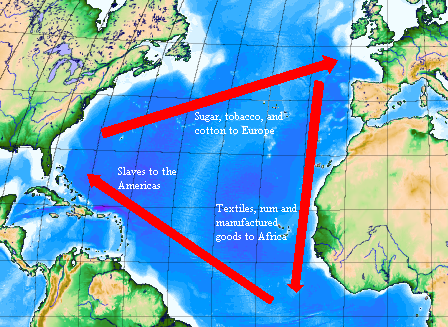Topic 4.5 Maritime Empires Maintained and Developed
Revision as of 08:58, 26 October 2020 by Jhenderson (talk | contribs) (Created page with " We right|thumb|A peso de ocho, or piece of eight.saw in the previous period (600-1450) that the creation of a common currency in China facilit...")
We
saw in the previous period (600-1450) that the creation of a common currency in China facilitated trade in that region. Widely accepted currencies speed up transactions and provide standardized way for merchants to measure the value of products. In this period the use of a common currency expanded from regional to global use. The Spanish peso de ocho, or "piece of eight," was the first currency in history to be used globally.
- This currency was the product of Spain's mining of enormous amounts of silver in the New World. In present day Bolivia and Mexico, they discovered massive deposits of silver, including a mountain full of silver at Potosi. After the purest veins of silver were quickly strip-mined production slowed; then the Spanish introduced the amalgamation method of using mercury to extract silver from ore. Production soared. In two centuries the silver mines of the Spanish New World produced 40,000 tons of silver. [1] The industrial centers that grew around these mines minted 2.5 million silver coins per year. The peso de ocho, worth about 80 US dollars today, gained acceptance around the world and lubricated global trade on an unprecedented level. Mughal India wanted Spanish silver for payment for its pepper sales, and this surge of silver funded Shah Jahan's construction of the Taj Mahal. Much of the Spanish silver ended up the hands of the Chinese, who had no desire for European products but readily accepted silver as payment for its coveted exports. The peso do ocho was even accepted currency in the United States until the Coinage Act of 1857. [2]
- C. In the early 1600s European countries found new methods of financing exploration and business. Since trading ventures were too expensive for most individuals to fund, investors began to pool their resources together into organizations called joint-stock companies. The most famous of these, the British East India Company (EIC), began in 1600 when the British government gave 218 London investors a royal monopoly of all trade east of the Cape of Good Hope. Established about one year later was the Dutch East India Company, known as the VOC. They were initially a much larger and wealthier rival of the EIC, with 10 times the capital resources of its British counterpart. Joint-stock companies proliferated. The Dutch West Indies Company traded in the New World and founded New Amsterdam, today New York City. And the Virginia Company of London was given a monopoly on the mid-Atlantic coast of North America.
- Joint-stock companies were an improvement over traditional partnerships because of something called limited liability. In a partnership, investors pool their resources together and share the profits or losses collectively. In the case of a shipwreck or some other calamity, however, investors would owe more than they put in and could be driven to bankruptcy. But the limited liability of a joint-stock company meant that an investor could never lose more than what he paid in. With risks thus limited but the potential for profit still high, joint-stock companies attracted thousands of investors willing to put up money, called stock, in these ventures.
- Voyages funded by joint-stock companies were more efficient and profitable than those funded by monarchs. Unconcerned with religious conversion, their voyages were streamlined to produce as much profit as possible in order to please investors and attract more capital. Thus countries such as Spain and Portugal, in which the king financed business, could not compete with the more efficient business practices of companies. Spain endured only as long as it could drain the New World of its silver reserves.
- This currency was the product of Spain's mining of enormous amounts of silver in the New World. In present day Bolivia and Mexico, they discovered massive deposits of silver, including a mountain full of silver at Potosi. After the purest veins of silver were quickly strip-mined production slowed; then the Spanish introduced the amalgamation method of using mercury to extract silver from ore. Production soared. In two centuries the silver mines of the Spanish New World produced 40,000 tons of silver. [1] The industrial centers that grew around these mines minted 2.5 million silver coins per year. The peso de ocho, worth about 80 US dollars today, gained acceptance around the world and lubricated global trade on an unprecedented level. Mughal India wanted Spanish silver for payment for its pepper sales, and this surge of silver funded Shah Jahan's construction of the Taj Mahal. Much of the Spanish silver ended up the hands of the Chinese, who had no desire for European products but readily accepted silver as payment for its coveted exports. The peso do ocho was even accepted currency in the United States until the Coinage Act of 1857. [2]
- D. Since the classical age several major trade routes dominated trans-regional trade. Political, environmental and demographic changes altered the ebb of flow in the volume of trade and gave each a turn at being the dominant trade route. These major routes coexisted for most of this time and no major new networks were added. Between 1450 and 1750, however, an entirely new trade route emerged and became the world's dominant network of exchange. The Atlantic System connected the old and new worlds in a triangular pattern across the ocean. A truly global system of trade was established.
- In an effort to make trade as efficient as possible, ships in this triangular pattern never sailed empty. From Africa, they sailed across the Atlantic to the New World with slaves. After selling the slaves, they sailed to Europe with sugar, tobacco, and rum. After loading their ships with alcohol, metal items, and guns, they said to Africa's west coast to trade these things for slaves and begin the circuit all over again.
- D. Since the classical age several major trade routes dominated trans-regional trade. Political, environmental and demographic changes altered the ebb of flow in the volume of trade and gave each a turn at being the dominant trade route. These major routes coexisted for most of this time and no major new networks were added. Between 1450 and 1750, however, an entirely new trade route emerged and became the world's dominant network of exchange. The Atlantic System connected the old and new worlds in a triangular pattern across the ocean. A truly global system of trade was established.
- ↑ Silver, Trade, and War: Spain and America in the Making of Early Modern Europe, (2000), Stanley J. Stein, Barbara H. Stein, p. 21.
- ↑ http://memory.loc.gov/cgi-bin/ampage?collId=llsl&fileName=011/llsl011.db&recNum=184




